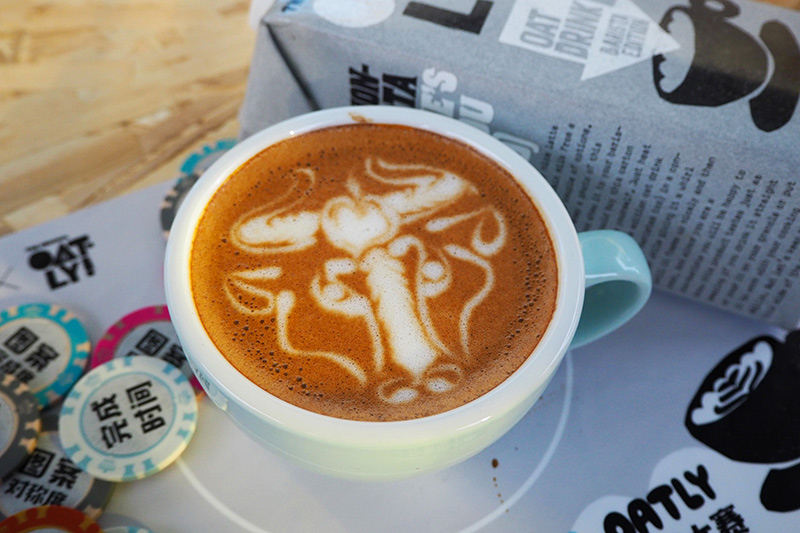中国人普遍乳糖不耐受,所以这家公司火了

|
小众的咖啡师,是来自于瑞典的欧特力(Oatly)切入国际市场的优先选择。 在中国的“第三次浪潮”下的文青咖啡店,欧特利别具特色的包装盒的能见度越来越高。欧特力(Oatly)——如其英文名字所指——是用燕麦片造出的像牛奶一样的饮品,欧特力称已经与香港80%的文青咖啡店建立了合作关系。欧特力饮品已经大量涌入中国南部港口,现在正在向北拓展,等待它们的是更为巨大的内地市场。 “有些报道说,中国政府希望中国的乳品消费能够增加两倍,我想在这方面我们可以提供大力支持。”欧特力的首席执行官托尼·彼得森说。欧特力在上海设立了办公室,产品铺进了中国2200家咖啡馆和零售店,这家有着25年历史的公司甚至还造了一个中文字——上面是草字头,下面是个奶字——用以控制植物基奶的话语权。 这是聪明的一步棋。欧盟的法规不允许燕麦饮品厂家在本土市场上称欧特利为“牛奶”。乳品业游说人士正在试图推动美国也出台类似法规。不过,彼得森坚持认为欧特力不会把其新造的中文字注册为商标,而是会把它作为开放的源头,来鼓励围绕乳业的各种对话。 |
Niche barista joints are the preferred point of entry into foreign markets for Sweden’s Oatly. In Hong Kong, its stylized cartons are an increasingly common sight in hipster “third wave” coffee shops. Oatly, which—as its name suggests—creates a milk-like product from milled oats, claims to have partnered with 80% of such coffeehouses in the city. Having already stormed into the southern port, Oatly is beginning an expansion north into mainland China, where a much larger market awaits. “Some reports say the Chinese government wants to triple dairy consumption in China, and I think we could be very helpful in supporting that development,” says Oatly CEO Toni Petersson. With an office in Shanghai and sales through more than 2,200 Chinese coffee shops and retailers, the 25-year-old company has even coined a Chinese character—the symbol for grass atop the one for milk—to help control the narrative about plant-based milk. That’s a clever move. EU regulations prevent the oat-drink manufacturer from calling Oatly “milk” in its home market. Dairy lobbyists are pushing for similar restrictions in the U.S. However, Petersson insists Oatly won’t trademark its new Chinese character but will keep it open-source to help encourage dialogue around dairy alternatives. |

|
乳业在中国蓬勃发展。去年乳业的零售总额超过了610亿美元,而10年前仅为270亿美元,这一数据来自于市场研究机构欧睿国际。(美国乳业市场达650亿美元,但最近三年有所下滑。)增长的原因部分是政府在2016年倡议民众日均牛奶摄入量从100克增加到300克,但主要还是经济发展的结果。 中国乳业似乎已经克服了一个障碍,那就是乳糖不耐受的问题。据1984年的一份研究,90%的中国人的体内缺少乳糖酶,这是一种能够在胆内分解乳糖的酶。但随着中国人在饮食中加入了更多的乳品,他们体内的乳糖酶活性也增强了。而在80年代,很多中国人都不喝牛奶。 “一旦经济发展了,乳糖消化不良的问题就不再是问题。”荷兰乳业公司皇家菲仕兰康柏尼的首席执行官海恩·舒马赫说。菲仕兰康柏尼在中国销售多种品牌的乳品,包括在香港最受欢迎的婴儿配方乳品Friso。 随着中国经济的发展,乳品销量当然也增长了,不过欧睿国际的数据显示,低乳糖含量的乳品——奶酪、黄油和奶油——是销量涨幅最快的产品类别。而且,销往食品服务业的乳品数量要超过零售,这意味着相当一部分的乳品进入到了加工食品或饮料里。 “芝士茶”是一种暖暖的带糖茶,上面覆盖着一层厚厚的类似于奶油芝士的奶泡,这种茶在中国正在风靡起来。菲仕兰康柏尼已经把它从欧洲市场带来的一款卡布奇诺咖啡机重新定位成芝士茶机。舒马赫甚至觉得这种新潮的饮品在西方也会流行起来,或许会,或许不会,但中国人对乳品的需求将以另一种方式影响世界其他地方。 |
Dairy is an exploding business in China. Last year the retail value of its industry passed $61 billion, up from $27 billion 10 years ago, according to market research provider Euromonitor International. (The U.S. dairy market is at $65 billion but has declined in the past three years.) The increase is explained in part by Beijing’s recommendation in 2016 that citizens up their daily dairy intake from 100 grams to 300 grams. But it’s mostly a result of economic development. One hurdle the Chinese dairy industry seems to have overcome is lactose intolerance. More than 90% of China’s population is deficient in lactase, the enzyme that breaks down the milk sugar lactose in the gut, per a 1984 study. But lactase activity increases as people add more dairy to their diet. In 1980s China, not many people were drinking milk. “Once you see societies developing economically, the notion of lactose intolerance seems to become less of a problem,” says Hein Schu¬macher, CEO of Netherlands-based dairy firm FrieslandCampina, which sells a number of dairy brands in China, including Hong Kong’s most popular infant formula, Friso. Dairy sales certainly are rising as China’s economy grows, although data from Euromonitor International shows that low-lactose dairy—cheese, butter, and cream—are the fastest-growing segments. Also, sales to the food-service industry outstrip retail sales, suggesting that a significant portion of dairy is going into processed foods or drinks. “Cheese tea,” which is warm sugary chai capped with a thick dairy froth similar to cream cheese, is a growing craze in China. FrieslandCampina has actually repurposed a cappuccino machine from its European market to sell as a cheese-tea machine in China. Schumacher suspects the novelty beverage could even catch on in the West. Maybe, maybe not, but China’s thirst for dairy will impact the rest of the world in another way. |

|
去年荷兰的瓦赫宁恩大学暨研究中心出了一份报告指,为了满足中国人日益增长的对牛奶的需求,乳制品造成的全球温室气体排放到2050年会增长35%。这种增幅部分原因在于中国国内的乳品制造业效率很低——产出只有美国的一半。 在菲仕兰康柏尼的全球可持续发展倡议中,有一部分内容是与中国农民合作,提高他们的效率。尽管这一举措如整个倡议一样令人尊敬,其效果堪忧。瓦赫宁恩大学报告的联合作者杰拉德·维尔特霍夫说:“即便中国乳业的效率急剧提升,乳业带来的全球温室气体排放和氮气排放也将上升20%~25%。因为无论如何,中国对牛奶的需求上升终将带来全球性的影响。” 于是,欧特力认为自己就是那个拯救者。“我们所做的事有一个奇怪的地方,那就是我们卖得越多,对所有人越有利。”彼得森不无得意地说,他声称欧特力的碳排放要比乳业少80%。(2018年牛津大学的一项调查发现,全球平均来看,燕麦基奶产业带来的排放要比乳业少60%。)这个信息可能引起中国富有的千禧一代和崛起中的Z世代人的共鸣,他们看重产品的环保属性——即便是用一次性杯在喝着生态环保的燕麦奶。 欧特力计划在亚洲开一家工厂——这将是全球新开的三家厂之一——明年竣工,用以覆盖整个区域。彼得森说:“三到五年内,中国将会成为我们真正重要的市场。”(财富中文网) 本文另一版本登载于《财富》杂志2019年8月刊,标题为《中国的燕麦奶》。 译者:Min |
Last year a report by Netherlands-based Wageningen University & Research found that satisfying China’s increasing demand for cow’s milk could increase global greenhouse-gas emissions from dairy production 35% by 2050. That spike is partly because China’s domestic dairy production is so inefficient—achieving roughly half the yield of the U.S. industry. As part of its global sustainability initiative, FrieslandCampina works with Chinese farmers to help improve their efficiency. But as admirable as that initiative is, its efforts might be moot. Wageningen report coauthor Gerard Velthof says, “Even if the efficiency of the dairy industry in China is drastically increased, global emissions of greenhouse gases and nitrogen produced by this sector will still rise by 20% to 25%. The predicted increase in China’s demand for milk will have major global consequences, whatever the scenario.” Here’s where Oatly considers itself a savior. “The strange thing about what we do is the more we sell, the better it is for everybody,” ¬Petersson says, claiming Oatly’s carbon footprint is 80% smaller than the equivalent of dairy. (A 2018 Oxford University study found the global average for oat-milk production was 60% less emissions than those for dairy.) That’s a message that should resonate with China’s wealthy millennials and emergent Generation Z, who value products with environmental positioning—even if they will take their eco-friendly Oatly lattes in disposable cups. Oatly plans to open a factory in Asia—one of three new plants globally—next year to help cover the region. “In three to five years,” Petersson says, “we think China is going to be really, really important for us.” A version of this article appears in the August 2019 issue of Fortune with the headline “Milking Oats for China.” |













